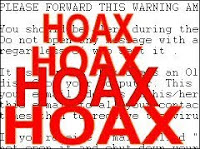 In those beginning days of using email and the Internet, like everyone else I panicked when that first “virus warning” landed in my mailbox. I sent it to everyone, just like most people do. However, a more experienced friend pointed out that almost all of these warnings are hoaxes.
In those beginning days of using email and the Internet, like everyone else I panicked when that first “virus warning” landed in my mailbox. I sent it to everyone, just like most people do. However, a more experienced friend pointed out that almost all of these warnings are hoaxes.This friend also showed me how to discern true from false. I could go to the websites of those who know and see what the experts have to say about each message. Since then, I’ve disregarded most of these “warnings” and discouraged others from passing false information. Instead, they should first test it.
Jesus said the same thing about spiritual truth and warned about those who pass along false information.
Beware of false prophets, who come to you in sheep’s clothing, but inwardly they are ravenous wolves. You will know them by their fruits. Do men gather grapes from thornbushes or figs from thistles? (Matthew 7:15-16)My devotional reading points out that a false teacher isn’t going to identify himself as such. Instead, they claim to be from God and that they speak for Him. Jeremiah 5:31 says, “The prophets prophesy falsely, and the priests rule by their own power; and My people love to have it so.”
In those days as well as today, false teachers can be difficult to identify. Today, they usually appear to be nice people with pleasant and positive attitudes. They know how to talk and act like Christians and seem very sincere. They also seem happy and well adjusted. As far as judging them by their attitude, that is not easy.
They cannot be judged by the size of their following either. Many false teachers have thousands and even millions of followers. While Jesus did say that many are on that broad way that leads to destruction, there is a tendency to ask how so many people could be wrong. They even do good things that seem right. Just as the Bible mentions, some who prophesy, or cast out demons, or do miracles in Jesus’ Name. People must have wondered then as they do today, “What is greater evidence of authority than these things?”
During the time written of in Matthew, Christ was interpreting the Old Testament law for the people. He made it clear that the Word of God is superior to any miracle. Even the early Scriptures said that if a sign or prediction actually did come to pass, if the message is not according to the Word of God it was to be rejected and false teachers were to be executed (See Deuteronomy 13).
When Jesus offered these words in Matthew 7, the people also must have wondered how to tell the difference between true and false. To help them, Jesus told of two houses. One was built on the sand and the other on the rocks. The key difference between them was not their external appearance, but how they stood up when tested.
Just like the houses, the scribes and Pharisees seemed to be as righteous as those who put their faith in Jesus, but the difference was in their foundations and in how they passed the tests.
As I think about this, the best way to identify a false prophet is by testing what they teach. Some may never mention basic doctrines such as Christ’s deity and His sacrificial and substitutionary atonement. Some will not agree about the sinfulness of humanity, or that unbelievers’ are destined for eternal separation from God in hell. Yet whenever they say anything about spiritual matters, it must be carefully examined.
The Bible talks about the Bereans who “were of more noble character than the Thessalonians, for they received the message with great eagerness and examined the Scriptures every day to see if what Paul said was true” (Acts 17:11).
This is what God wants Christians to do. We need to discern true from false. We should check out what they say, and even check out what other Christians say. The Bereans may not have been suspicious of Paul but that they realized how easily the human heart can be duped. They also knew that the only way to know for sure whether someone is passing on truth is by checking it out with the expert on truth, the Word of God.
No comments:
Post a Comment